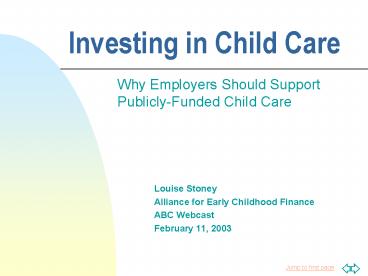Investing in Child Care - PowerPoint PPT Presentation
1 / 19
Title:
Investing in Child Care
Description:
Title: It s Not Just About Money Author: Louise Stoney Last modified by: TASchelling Created Date: 4/12/2002 6:34:28 PM Document presentation format – PowerPoint PPT presentation
Number of Views:57
Avg rating:3.0/5.0
Title: Investing in Child Care
1
Investing in Child Care
- Why Employers Should Support Publicly-Funded
Child Care - Louise Stoney
- Alliance for Early Childhood Finance
- ABC Webcast
- February 11, 2003
2
Child care is many things
- Child care centers
- Family child care homes
- Head Start public prekindergarten
- School-age child care recreation
- Summer camps
- Informal care (relatives, friends and
neighbors) - Parental leave
- Flex-time other family friendly policies
3
Child care programs provide early education
- Children dont wait until school starts to begin
learning...
4
Child care is important because...
- Your future employees are enrolled in child care
today. - Many of your current employees rely on child care
so they can work. - Supporting child care is good business.
- The economic viability of our communities -- and
the country as a whole -- is strengthened by the
child care industry.
5
(No Transcript)
6
It doesnt make sense.How could child care
possibly cost more than college?
- Good question -- and you are right. It doesnt
cost more to provide early education than higher
education. But the price is higher. Why? - College education is heavily subsidized. Colleges
have access to a host of revenue sources. As a
result, tuition revenues cover only a small
percentage of the total cost. - Child care, on the other had, has almost no
direct subsidies. Tuition is the primary -- and
sometimes the only -- revenue source.
7
(No Transcript)
8
Factors that drive child care costs
- Staff to child ratios are mandated.
- Personnel costs are the largest item in a budget
(often 70 ) and wages are already too low. - Occupancy costs are second largest budget item.
- Centers are very small -- almost no economies of
scale.
9
(No Transcript)
10
Key points
- The private sector cant bail government out.
Even if private funds increased four-fold they
would still represent a small slice of the
overall child care finance pie. - Government funds are largely targeted to
low-income families, and are paid to child care
providers in lieu of parent fees. Thus, they
dont help the bottom line. - Still, publicly-funded child care scholarships
are an important support for some
industries--especially services and retail trade.
11
Families who receive public child care subsidies
are clustered in the services retail trade
industries
12
A Case for Action
In most states, the services retail trade
sectors are leading job growth
Georgia Industry Employment Growth,1996-2006
Percentage Change
Construction
Finance, Insurance, Real Estate
Transportation
Services
Agriculture, Forestry, Fishing
Wholesale Trade
Communications, Public Utilities
Retail Trade
Source Occupational Outlook, 1996-2006
13
Child care supports economic development
- A healthy economy requires strong businesses and
productive workers. Child care not only fuels
that strength, it's an industry that provides
positive, short term returns. - While typically not viewed as such, child care
businesses comprise a rapidly growing industry
that contributes a significant amount of economic
activity by developing jobs, generating tax
dollars, and pumping money into local economies
through the purchase of goods and services. - Just as roads, airports, and bridges enable
people to get to work and businesses to get their
supplies, child care enables parents to work.
14
The child care industry contributes to the economy
- In Kansas, the child care industry employs more
people than important industries like hotels,
farm machinery and oil bearing crops. - In Milwaukee, Wisconsin, the child care industry
generates almost 204 million in gross
receipts--more than spectator sports, hotels,
engineering firms. - In San Antonio, Texas, every 1 invested in child
care returns 1.46 to the city in additional tax
revenue. - In Tompkins County, New York, every 1 spent on
publicly funded child care scholarships returns
as much as 3.60 to the local economy.
15
The bottom line If we separate
employer-supported child care and publicly-funded
child care strategies, we are missing the boat.
- For businesses that hire lower-wage workers,
publicly-funded child care is an important
employer support. - And for businesses that hire moderate and
middle-income families, the lack of public
support for child care is not only a serious
problem, its a missed economic opportunity.
16
So.what can be done about this?
- Child care needs more broad-based public funding
(in other words, not just funds for poor
families). - Child care needs new, innovative financing
strategies that involve strategic alliances among
the public and private sectors. - Child care providers need new fiscal and
management approaches that promote stability and
economies of scale.
17
What companies can do
- Spearhead new partnerships that leverage public
and private funds for child care. Examples the
Florida Executive Partnership,Colorado Educare,
Kansas City Ready for School partnership. - Support public child care funding. Examples
Florida An Hour a Week for Kids initiative,
Massachusetts Early Education for All campaign,
National Corporate Voices for Working Families
and Committee for Economic Development.
18
What companies can do
- Help craft new financing strategies that build on
successful models from other fields. Examples
innovative use of tax policy, like Oregons new
child care investment tax credit or Colorados
proposal for a new school-readiness tax credit. - Encourage state community economic development
agencies to work with the child care industry.
Examples Maine Business Commission, California
LINCC projects. - Help the child care industry craft new fiscal and
administrative strategies to reach economies of
scale. - Maybe add something from NC? Ask Abby, Anne,
others...
19
What companies can do
- Help the child care industry craft new fiscal and
administrative strategies that can stabilize the
industry and allow these small businesses to
reach some economies of scale.

